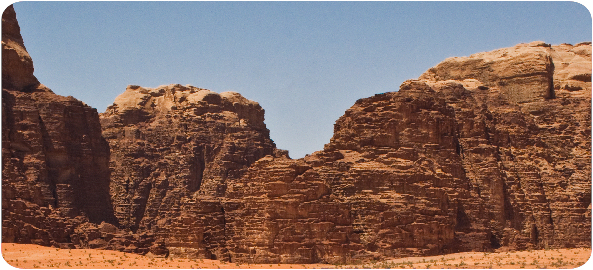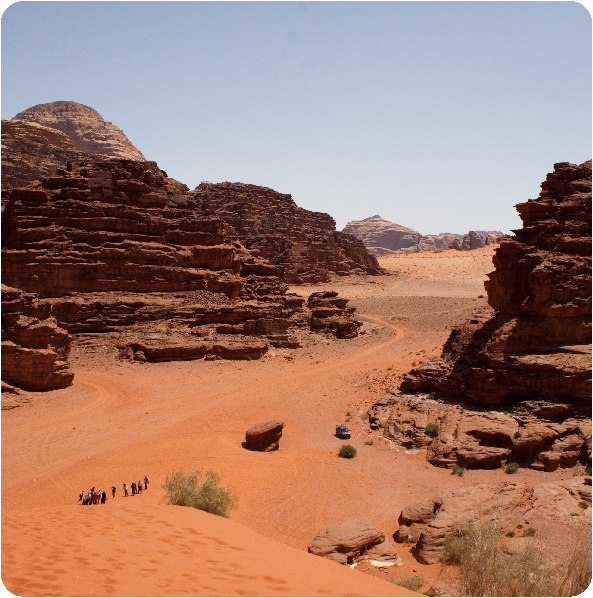
Wadi Rum
Wadi Rum (also Wadi Ramm, Wadi is arab for "valley"), about 60km east of Aqaba, is the largest Wadi in Jordan and definitely one of the most beautiful places you can visit in this part of the world.
A place where soft sand and timid vegetation stand opposed to rough cliffs and steep dunes and the mountains seem to have been thrown randomly into the red desert sand.
T.E. Lawrence, also known as Lawrence of Arabia, who based his operations during the Arab Revolt 1917-18 here, was already stunned by the "crimson sunset" on "stupendous cliffs" and "slanted ladders of hazy fire", which have lost nothing of their spectacularity since then.
History of Wadi Rum
Ever since the Neolithicum (between the 8th and 6th century BC) Wadi Rum has been inhabitated by various cultures and tribes.
The oldest signs of human inhabitation go back to the Minaeans and other Arabic tribes like the Ad, Thamud, Lihyan and Main. The Ad tribe were the ones to originally construct the Allat Temple found at the foot of Jabal Rum.
Later on, the Nabataeans settled in this area, starting successful trade relationships with other tribes and leaving their marks and inscriptions for millennia to come.
On top of these Nabataean inscriptions Thamudic signs and sketches have been found, showing their involvement in the construction of this sanctuary.
During World War I. Wadi Rum was the headquarters of Prince Feisal bin Al-Hussein and T.E. Lawrence, planning their maneuvers against the Ottoman Empire.
In the 60s Wadi Rum became famous for being the filming spot of the movie "Lawrence of Arabia" starring Peter O'Toole and Omar Sharif and receiving 7 Oscars in 1963.
Since June 2011 Wadi Rum is inscribed as World Heritage by the UNESCO.
Geology of Wadi Rum
It is assumed that the rifts of Wadi Rum are a spin-off from the series of cataclysms that created the Great Rift Valley in Africa and the Jordan Valley.
This upheavel shattered mammoth pieces of granite and sandstone ridges from the mountains of the Afro-Arabican Shield and distributed them in the criss-crossing fault lines we see today.
The pre-Cambrian granite basis (about 2000 million years old) of the Wadi lies mostly beneath the surface, topped by sandstone pillars from various ages and colours: red sandstone from the Cambrium (600 million years old) below grey Ordovician (500 million) and pale beige Silurian sandstone (400 Million). Erosion formed the structures we see today, resembling pillars, organ pipes or dripping candle wax.
To log this Earthcache
- Always: Answer the following question:
Kha'zali Canyon used to be an important water reservoir for the inhabitants of Wadi Rum. When hiking into the Canyon measure or estimate the size of the water hole at the back. Send your answer to me via internal message.
- Optional: Take a picture of yourself and/or your GPS at Kha'zali Canyon or any other famous site in Wadi Rum, e.g. the Little Bridge, the Great Sand Dune, Burrah Canyon or the Seven Pillars of Wisdom.
- You can immediately log your find without waiting for permission. Tell us a bit about your experiences in Wadi Rum. And don't forget to append your picture if you made one!
- If there is a problem with anything in this text, give me a short message and I'm sure we can work something out. :)
Please note
To enter Wadi Rum you need to pay an entrance fee at the Visitor's Center and usually you book a tour at one of the local tourism offices run by the bedouins. I highly recommend staying for a night not only for the sunset, the beautiful stars and the experience of sleeping in the desert, but also for the delicious food and the entertaining evening your hosts will present to you.

Sources and additional information